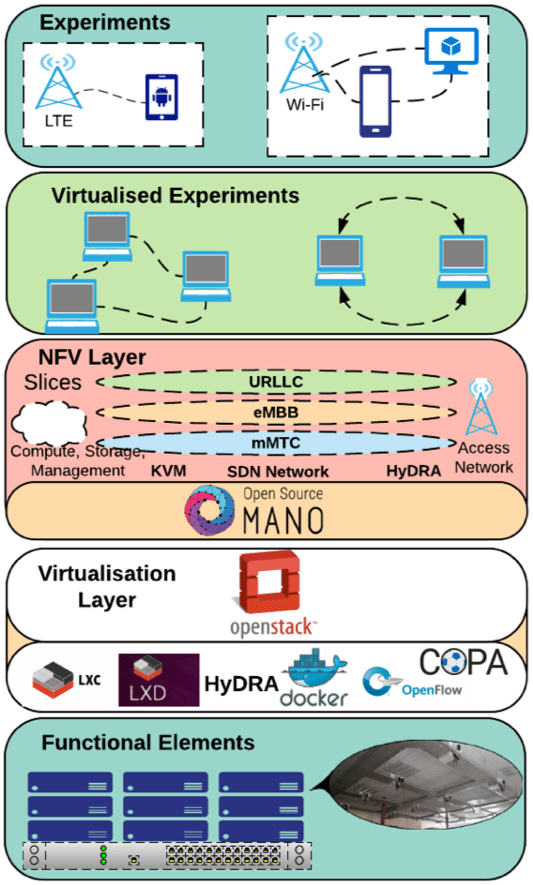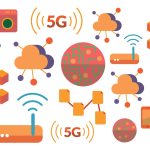What is IRIS?
Iris – the reconfigurable radio testbed at Trinity College Dublin provides virtualized radio hardware, software virtualization, Cloud-RAN, Network Functions Virtualization (NFV), and Software-Defined Networking (SDN) technologies to support the experimental investigation of the interplay between future networks and new radio. Our facility pairs underlying flexible radio and computations resources with various hypervisors in the form of Software-Defined Radio (SDR) frameworks, virtualized network functions (VNFs), and SDN network slicing capabilities to realize various research and experimentation configurations. We employ a Dell Networking S4048T-ON high-performance SDN/OpenFlow 1.3 enabled switch connected to underlying radio devices. Radio resources include 24 NI USRP N210 ceiling-mounted nodes equipped with SBX daughterboards supporting frequency ranges of 400 MHz-4400 MHz offering up to 20 MHz of bandwidth. This equipment supports experimentation with Wi-Fi, WiMAX, S-band transceivers and 2.4 GHz ISM band transceivers, and so forth. We also employ 5 NI USRP X310s supporting DC – 6 GHz frequencies and up to 40 MHz of baseband bandwidth. These platforms are connected to a private computational cloud based on the OpenStack suite of technologies, allowing us to deploy an array of dynamic virtualised computational environments. To expose the functionality of these platforms for applications, we employ a variety of radio hypervisors that freely enable prototyping of wireless systems, as exemplified by GNURadio, srsLTE 3GPP, and Open-Air Interface. These radio hypervisors combined with dynamic distributed network functions enable the realization of heterogeneous radio platforms that can support malleable and adaptable networks. Iris is ideally equipped to investigate the combination of SDR and radio slicing, SDN, network functions virtualisation, and physical layer approaches into coexisting and coherent next-generation commercial networks, including but not limited to 5G.

High-Level Iris Testbed Architecture
A high-level overview of Iris testbed architecture is depicted in Figure 1. The physical layer, at the bottom, represent the tangible resources including servers, switches, USRPs, and so forth, at the Iris testbed. The virtualisation and control layers in the middle are supported by software virtualisation technologies such as OpenStack to support cloud computing, OpenFlow to orchestrate and manage the USRPs and physical network equipment. The vertical and NFV MANO layers, are supported by the Open Source Network Function Virtualization (NFV) Management and Orchestration (MANO) (OSM) software stack. These elements interact with the physical and virtualisation layers to dynamically instantiate radio Experimental Vertical Instances (EVIs) at the Iris testbed.
Iris Testbed Functional Layers
Logically, the Iris testbed can be thought of as consisting of five functional layers, as illustrated in Figure 2. These include:
- Functional Elements: The bottom layer represents the physical resources, such as servers, switches, National Instruments (NI) USRPs N210 and X310, commercial Wi-Fi equipment etc.
- Virtualisation Layer: To expose the functionality of physical equipment for applications, Iris employs a variety of hypervisor tools and technologies. This layer provides support for open source cloud virtualisation technologies (OpenStack), SDN techniques (OpenFlow 1.3, and Open vSwitch), custom Linux images, and Software-Defined Radio (SDR) elements including GNU Radio, srsLTE, Open Air Interface.
- NFV Layer: OSM supports the deployment of Experimental Vertical Instances (EVIs) across the Virtualisation and Functional Layer elements, by supporting the creation of virtual machine instances and instantiation of communication between virtual machines in physical rack servers. These elements provide a fully functional orchestrator for EVIs at Iris.
- Virtualised Experiments: The next layer corresponds to the virtualised testbed resources, allocated to the experimenter for a specific period of time.
- Experiments / 5G Application: This layer sits at the top and is defined and controlled by the experimenter. It is the EVI environment that supports a 5G end-to-end application that can fully utilise the virtualised resources offered by the lower layers.

Iris Hardware and Software elements
Table 1 provides an overview of the hardware and software components available at the Fed4FIRE+ Iris testbed.
Table 1: summary of hardware and software elements available in at the Iris testbed at Trinity College Dublin
| Iris Testbed (Hardware & Software) | ||
|---|---|---|
| 25 x NI USRP N210s with SBX daughterboards supporting frequencies between 400 MHz and 4.4 GHz | 60 x SMA Direct Connect Wi-Fi 2.4GHZ/5GHZ Antennas | 5 NI USRP X310s supporting DC – 6 GHz frequencies with SBX and CBX daughterboards offering up to 40 MHz of baseband bandwidth |
| 12 x Dell PowerEdge R440 servers and 3 R620 servers (acting as an OpenStack Controller and Compute nodes) | 35 x ports on a Dell Networking S4048T-ON SDN switch. Orchestrated by ONOS | Commercial Wi-Fi routers (2.4GHz and 5GHz bands) |
| Open Network Operating System (ONOS), orchestrating USRPs | ETSI Open Source Management and Orchestration (MANO) OSM | GNURadio, srsLTE 3GPP, Open Air Interface, Custom Configuration on Linux Based Operating Systems |
| OpenStack (Rocky) with KeyStone, Glance, Nova, Neutron (type: self-service networks), and Horizon | 1 x 10GB Ethernet Controller (SR-IOV) to N210 USRPs on Dell S4048T-ON switch | HyDRA radio virtualization technology |
Contact
Email: wireless.testbed@connectcentre.ie
More details are available under: http://iris-testbed.connectcentre.ie/





